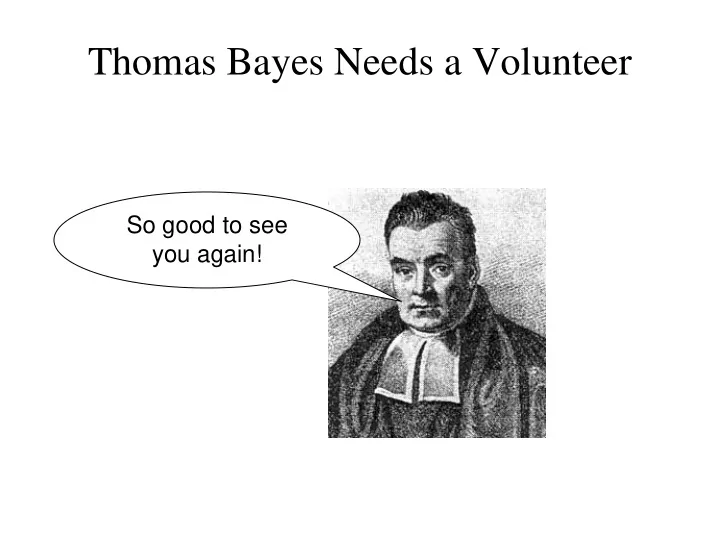

Thomas Bayes Needs a Volunteer So good to see you again!
Two Envelopes • I have two envelopes, will allow you to have one One contains $X, the other contains $2X Select an envelope o Before you open it, want to switch for other envelope? Open it. Would you like to switch for other envelope? To help you decide, compute E[$ in other envelope] o Let Y = $ in envelope you selected 1 1 5 Y = ⋅ + ⋅ = [ $ in other envelope ] 2 E Y Y 2 2 2 4 Before opening envelope, think either equally good So, what happened by opening envelope? o And does it really make sense to switch?
Discuss!
Two Envelopes Solution • The “two envelopes” problem set-up Two envelopes: one contains $X, other contains $2X You select an envelope and open it o Let Y = $ in envelope you selected o Let Z = $ in other envelope 1 1 5 Y = ⋅ + ⋅ = [ | ] 2 E Z Y Y Y 2 2 2 4 Before opening envelope, think either equally good o So, what happened by opening envelope? E[Z | Y] above assumes all values X (where 0 < X < ∞ ) are equally likely o Note: there are infinitely many possible values of X o Can’t have equal (non-zero) probabilities over infinitely many possibilities (total probability of all outcomes won’t sum to 1)
Subjectivity of Probability • Belief about contents of envelopes Since implied probability over X is not a true probability distribution, what is our probability distribution over X? o Frequentist : play game infinitely many times and see how often different values come up. o Problem: I only allow you to play the game once Bayesian probability o Have prior belief of probability for X (or anything for that matter) o Prior belief is a subjective probability • By extension, all probabilities are subjective o Allows us to answer question when we have no/limited data • E.g., probability a coin you’ve never flipped lands on heads
The Envelope, Please • Bayesian : have prior probability over X, P(X) Let Y = $ in envelope you selected Let Z = $ in other envelope Open your envelope to determine Y If Y > E[Z | Y], keep your envelope, otherwise switch o No inconsistency! Opening envelope provides data to compute P(X | Y) and thereby compute E[Z | Y] Of course, there’s the issue of how you determined your prior distribution over X… o Bayesian: Doesn’t matter how you determined prior, but you must have one (whatever it is) o Imagine if envelope you opened contained $20.01
The Dreaded Half Cent
Probability Gets Weird • Consider that we have three spinners: Each spinner has probability of getting some number You and opponent each pick a distinct spinner Person who spins highest number wins o You get to choose first!
Probability Gets Weird • Consider that we have three spinners: If you are only choosing between A and B, what is pick? o A has 0.56 chance of winning If you are only choosing between A and C, what is pick? o A has 0.51 chance of winning If you are only choosing between B and C, what is pick? o B has (0.56 + 0.22) x 0.51 + 0.22 x 1 = 0.6178 chance of winning A dominant and C dominated with two players
Probability Gets Weird • Consider that we have three spinners: What if we have three players and all spinners in play? o A has 0.56 x 0.51 = 0.2856 chance of winning o B has 0.22 x 0.51 + 0.22 x 1 = 0.3322 chance of winning o C has 0.49 x 0.78 = 0.3822 chance of winning o C is best choice with three players o A fares the worst with three players This is known as “Blythe’s Paradox” o What if spinners represent efficacy of three different medicines?
Recommend
More recommend